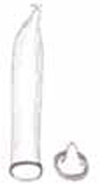2.2.3 Birth control options
The mother and her partner should also be counselled about birth control options. She may not be ready to decide about a method, but she needs to know the options. Her decision will be based on a number of factors, including her motivation in using a particular method, how many children she has, and whether she is breastfeeding.
Many options are available, which we will mention only briefly; the details of the different methods are addressed in the Module on Family Planning.
- Natural methods involve looking at the nature of the cervical mucus (quality and quantity), which can work fairly well to indicate when the woman is ovulating, but are not a secure way to prevent pregnancy.
- Breastfeeding exclusively and on demand by the baby can give reasonably good protection from pregnancy for up to six months, if the woman’s menstrual periods have not returned.

Barrier methods of contraception create a barrier between the male sperm and the vagina or cervix. The most commonly used barrier method is male condoms, which are widely available.
- Hormonal methods of contraception include contraceptive pills, injectable contraception, and implants (a tiny rod containing slow-releasing hormones which is put under the skin).
- Intrauterine devices (IUDs) are devices put inside the uterus to prevent implantation of an embryo; they can be inserted at the end of the puerperium.
- Permanent methods of birth control include cutting and tying the fallopian tubes (which extend from the uterus on either side towards the ovary) in females, and cutting the tube transporting male sperm from the testacles to the penis (vasectomy).
Without looking back at the sections above, write a very brief note for yourself of the key points that you will make to the parents of a newborn, advising them about caring for their baby.
Now check your list against the information in Sections 2.2.1, 2.2.2 and 2.2.3.
2.2.2 Rest and recovery for the mother
